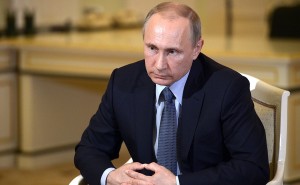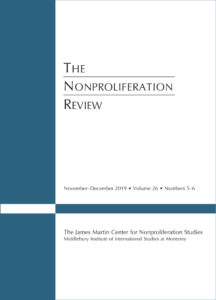March 31, 2022
Sanaa Alvira

Vladimir Putin. Photo courtesy Kremlin.ru.
Russia’s nuclear arsenal forms the backdrop to its invasion of Ukraine. This February, US President Joe Biden told NBC News that the United States would not send troops to defend Ukraine, since Americans fighting directly with Russians could lead to a “world war.” Russian President Vladimir Putin also hinted at the role of nuclear weapons, warning that anyone “who tries to stand in our way” would face consequences “such as you have never seen in your entire history.”
Under Putin’s leadership, Russia has invested heavily in keeping its nuclear forces credible against any opponent. Research published in the Nonproliferation Review by Hanna Notte, Sarah Bidgood, Nikolai Sokov, Michael Duitsman, and William Potter tracks innovations in Russia’s strategic arsenal. Examining public data from Russian-language sources, declassified intelligence documents, and commercial satellite imagery, the authors identify external and internal drivers behind Russia’s pursuit of novel weapons systems.
Putin’s wonder weapons
In a famous March 2018 address, Putin introduced a variety of cutting-edge weapons, including five new types of delivery systems that have few if any precedents. Several of these systems, including the Kinzhal air-launched ballistic missiles reportedly used in Ukraine this March, are “dual-capable” weapons, meaning that they could carry either conventional or nuclear warheads. The five new types are:
- Kinzhal, the dual-capable air-launched ballistic missile;
- Avangard, a missile with a nuclear-armed hypersonic glide vehicle payload;
- Burevestnik, a dual-capable, nuclear-powered cruise missile of global range;
- Poseidon, a nuclear-powered, long-range underwater drone; and
- Tsirkon, a hypersonic anti-ship cruise missile.
External and internal drivers
The authors find that all five weapons systems have been developed in response to external factors, while internal factors have influenced the scope and pace of their pursuit. Internal factors also determined which Soviet-era research and engineering initiatives informed later military innovation.
External drivers. Novel offensive weapons like Avangard and Burevestnik have been developed in response to US missile-defense programs, while Kinzhal and Tsirkon appear to have been driven by the perceived need to match US precision-strike capabilities. Poseidon is unusual; it may have been conceived with the aim of dissuading the United States from further developing its strategic missile defenses, but the characterization of the weapon has now evolved toward a “multipurpose system,” with significant war-fighting capabilities against surface ships and submarines, and not only against coastal targets.
Internal drivers. The common theme of novelty indicates the Russian government’s desire to enhance its prestige by outdoing other countries, but the selection of technologies also appears to reflect the anticipation of ancillary benefits for industry. Notably, too, most of these efforts have built on the foundations of unrealized Soviet-era programs, which may suggest a desire to recover past investments. Furthermore, each system’s ability to advance through the development process appears related to the extent of cooperation between different design bureaus and other defense-industry players.
Read this NPR article (Temporary open access)
About our journal
The Nonproliferation Review is a refereed journal concerned with the causes, consequences, and control of the spread of nuclear, radiological, chemical, and biological weapons. The Review features theoretical analyses, historical studies, viewpoints, and book reviews on such issues as state-run weapons programs, treaties and export controls, safeguards, verification and compliance, disarmament, terrorism, and the economic and environmental effects of weapons proliferation.
The Nonproliferation Review is produced at the Washington, DC offices of the James Martin Center for Nonproliferation Studies, Middlebury Institute of International Studies at Monterey. The journal is published by Taylor & Francis.

